Lancia Ypsilon 2011 Owner handbook (in English)
Manufacturer: LANCIA, Model Year: 2011, Model line: Ypsilon, Model: Lancia Ypsilon 2011Pages: 299, PDF Size: 13.35 MB
Page 101 of 299
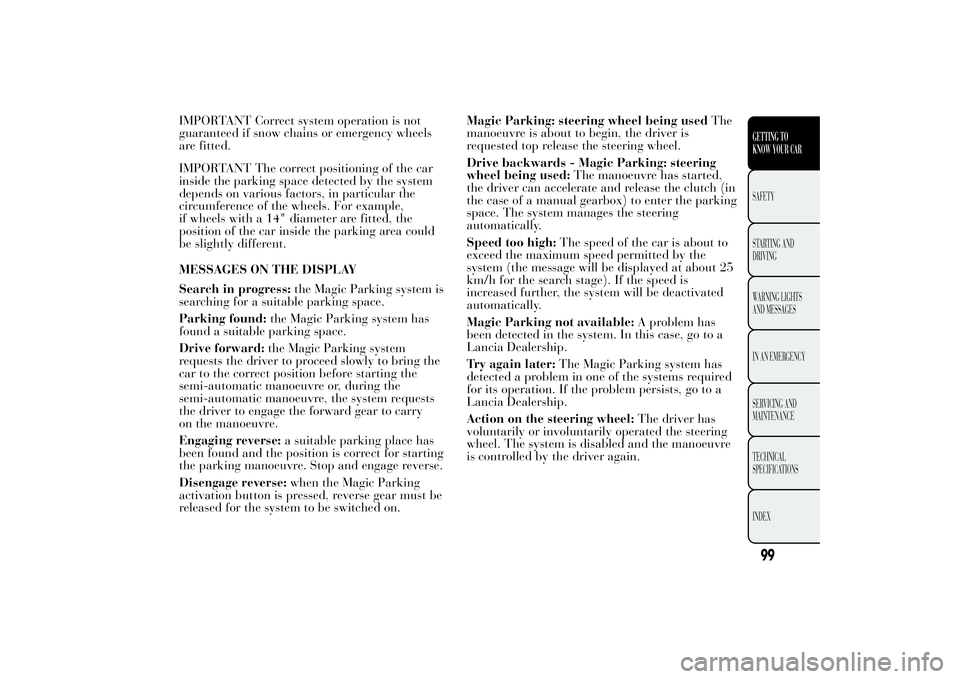
IMPORTANT Correct system operation is not
guaranteed if snow chains or emergency wheels
are fitted.
IMPORTANT The correct positioning of the car
inside the parking space detected by the system
depends on various factors, in particular the
circumference of the wheels. For example,
if wheels with a 14" diameter are fitted, the
position of the car inside the parking area could
be slightly different.
MESSAGES ON THE DISPLAY
Search in progress:the Magic Parking system is
searching for a suitable parking space.
Parking found:the Magic Parking system has
found a suitable parking space.
Drive forward:the Magic Parking system
requests the driver to proceed slowly to bring the
car to the correct position before starting the
semi-automatic manoeuvre or, during the
semi-automatic manoeuvre, the system requests
the driver to engage the forward gear to carry
on the manoeuvre.
Engaging reverse:a suitable parking place has
been found and the position is correct for starting
the parking manoeuvre. Stop and engage reverse.
Disengage reverse:when the Magic Parking
activation button is pressed, reverse gear must be
released for the system to be switched on.Magic Parking: steering wheel being usedThe
manoeuvre is about to begin, the driver is
requested top release the steering wheel.
Drive backwards - Magic Parking: steering
wheel being used:The manoeuvre has started,
the driver can accelerate and release the clutch (in
the case of a manual gearbox) to enter the parking
space. The system manages the steering
automatically.
Speed too high:The speed of the car is about to
exceed the maximum speed permitted by the
system (the message will be displayed at about 25
km/h for the search stage). If the speed is
increased further, the system will be deactivated
automatically.
Magic Parking not available:A problem has
been detected in the system. In this case, go to a
Lancia Dealership.
Try again later:The Magic Parking system has
detected a problem in one of the systems required
for its operation. If the problem persists, go to a
Lancia Dealership.
Action on the steering wheel:The driver has
voluntarily or involuntarily operated the steering
wheel. The system is disabled and the manoeuvre
is controlled by the driver again.
99GETTING TO
KNOW YOUR CARSAFETY
STARTING
AND
DRIVING
WARNING LIGHTS
AND MESSAGES
IN AN EMERGENCY
SERVICING AND
MAINTENANCE
TECHNICAL
SPECIFICATIONS
INDEX
Page 102 of 299
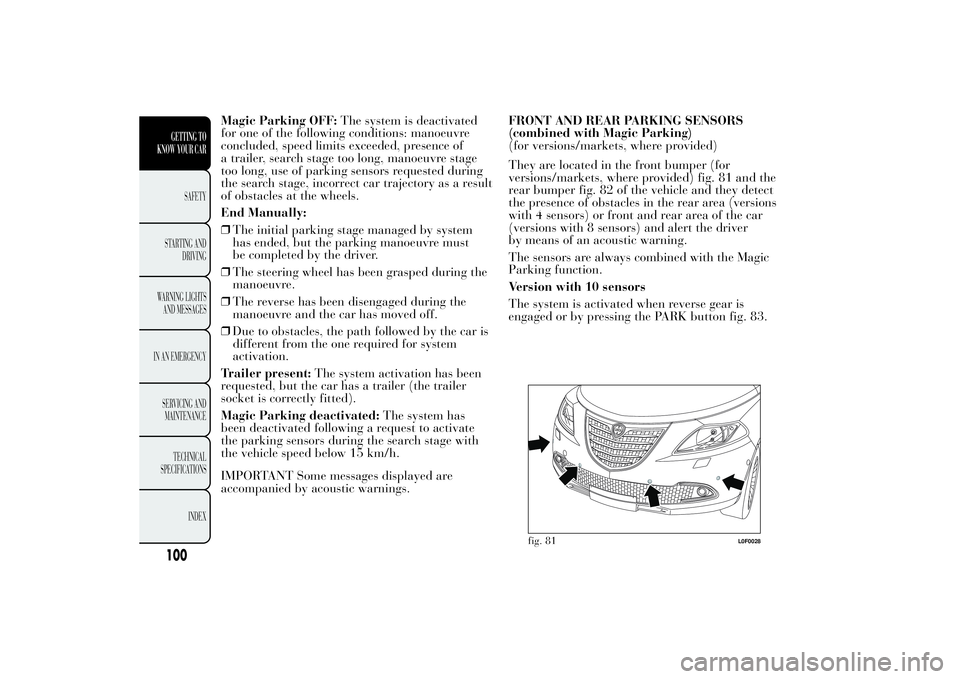
Magic Parking OFF:The system is deactivated
for one of the following conditions: manoeuvre
concluded, speed limits exceeded, presence of
a trailer, search stage too long, manoeuvre stage
too long, use of parking sensors requested during
the search stage, incorrect car trajectory as a result
of obstacles at the wheels.
End Manually:
❒The initial parking stage managed by system
has ended, but the parking manoeuvre must
be completed by the driver.
❒The steering wheel has been grasped during the
manoeuvre.
❒The reverse has been disengaged during the
manoeuvre and the car has moved off.
❒Due to obstacles, the path followed by the car is
different from the one required for system
activation.
Trailer present:The system activation has been
requested, but the car has a trailer (the trailer
socket is correctly fitted).
Magic Parking deactivated:The system has
been deactivated following a request to activate
the parking sensors during the search stage with
the vehicle speed below 15 km/h.
IMPORTANT Some messages displayed are
accompanied by acoustic warnings.FRONT AND REAR PARKING SENSORS
(combined with Magic Parking)
(for versions/markets, where provided)
They are located in the front bumper (for
versions/markets, where provided) fig. 81 and the
rear bumper fig. 82 of the vehicle and they detect
the presence of obstacles in the rear area (versions
with 4 sensors) or front and rear area of the car
(versions with 8 sensors) and alert the driver
by means of an acoustic warning.
The sensors are always combined with the Magic
Parking function.
Version with 10 sensors
The system is activated when reverse gear is
engaged or by pressing the PARK button fig. 83.
fig. 81
L0F0028
100GETTING TO
KNOW YOUR CAR
SAFETY
STARTING
AND
DRIVING
WARNING LIGHTS
AND MESSAGES
IN AN EMERGENCY
SERVICING AND
MAINTENANCE
TECHNICAL
SPECIFICATIONS
INDEX
Page 103 of 299
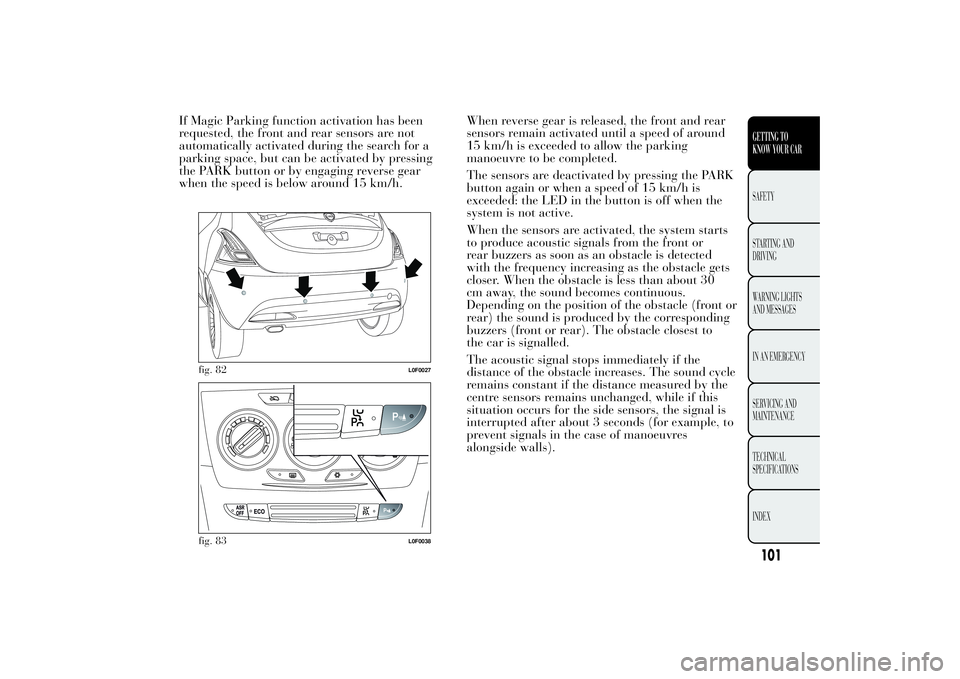
If Magic Parking function activation has been
requested, the front and rear sensors are not
automatically activated during the search for a
parking space, but can be activated by pressing
the PARK button or by engaging reverse gear
when the speed is below around 15 km/h.When reverse gear is released, the front and rear
sensors remain activated until a speed of around
15 km/h is exceeded to allow the parking
manoeuvre to be completed.
The sensors are deactivated by pressing the PARK
button again or when a speed of 15 km/h is
exceeded: the LED in the button is off when the
system is not active.
When the sensors are activated, the system starts
to produce acoustic signals from the front or
rear buzzers as soon as an obstacle is detected
with the frequency increasing as the obstacle gets
closer. When the obstacle is less than about 30
cm away, the sound becomes continuous.
Depending on the position of the obstacle (front or
rear) the sound is produced by the corresponding
buzzers (front or rear). The obstacle closest to
the car is signalled.
The acoustic signal stops immediately if the
distance of the obstacle increases. The sound cycle
remains constant if the distance measured by the
centre sensors remains unchanged, while if this
situation occurs for the side sensors, the signal is
interrupted after about 3 seconds (for example, to
prevent signals in the case of manoeuvres
alongside walls).
LANCIA
fig. 82
L0F0027
fig. 83
L0F0038
101GETTING TO
KNOW YOUR CARSAFETY
STARTING
AND
DRIVING
WARNING LIGHTS
AND MESSAGES
IN AN EMERGENCY
SERVICING AND
MAINTENANCE
TECHNICAL
SPECIFICATIONS
INDEX
Page 104 of 299
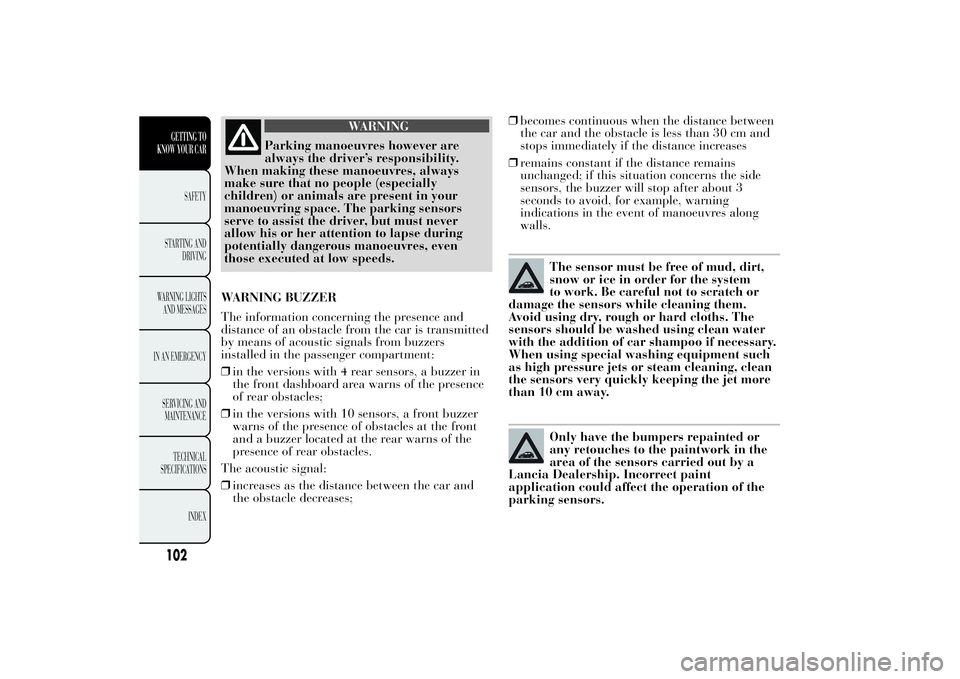
WARNING
Parking manoeuvres however are
always the driver’
s responsibility.
When making these manoeuvres, always
make sure that no people (especially
children) or animals are present in your
manoeuvring space. The parking sensors
serve to assist the driver, but must never
allow his or her attention to lapse during
potentially dangerous manoeuvres, even
those executed at low speeds.
WARNING BUZZER
The information concerning the presence and
distance of an obstacle from the car is transmitted
by means of acoustic signals from buzzers
installed in the passenger compartment:
❒in the versions with 4 rear sensors, a buzzer in
the front dashboard area warns of the presence
of rear obstacles;
❒in the versions with 10 sensors, a front buzzer
warns of the presence of obstacles at the front
and a buzzer located at the rear warns of the
presence of rear obstacles.
The acoustic signal:
❒increases as the distance between the car and
the obstacle decreases;❒becomes continuous when the distance between
the car and the obstacle is less than 30 cm and
stops immediately if the distance increases
❒remains constant if the distance remains
unchanged; if this situation concerns the side
sensors, the buzzer will stop after about 3
seconds to avoid, for example, warning
indications in the event of manoeuvres along
walls.
The sensor must be free of mud, dirt,
snow or ice in order for the system
to work. Be careful not to scratch or
damage the sensors while cleaning them.
Avoid using dry, rough or hard cloths. The
sensors should be washed using clean water
with the addition of car shampoo if necessary.
When using special washing equipment such
as high pressure jets or steam cleaning, clean
the sensors very quickly keeping the jet more
than 10 cm away.Only have the bumpers repainted or
any retouches to the paintwork in the
area of the sensors carried out by a
Lancia Dealership. Incorrect paint
application could affect the operation of the
parking sensors.
102GETTING TO
KNOW YOUR CAR
SAFETY
STARTING
AND
DRIVING
WARNING LIGHTS
AND MESSAGES
IN AN EMERGENCY
SERVICING AND
MAINTENANCE
TECHNICAL
SPECIFICATIONS
INDEX
Page 105 of 299
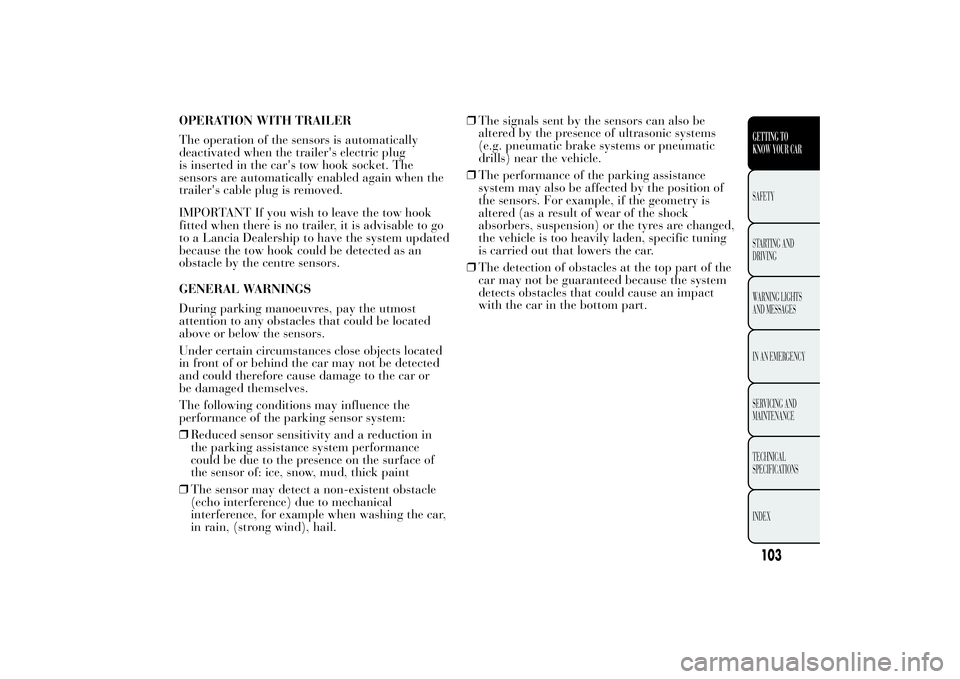
OPERATION WITH TRAILER
The operation of the sensors is automatically
deactivated when the trailer's electric plug
is inserted in the car's tow hook socket. The
sensors are automatically enabled again when the
trailer's cable plug is removed.
IMPORTANT If you wish to leave the tow hook
fitted when there is no trailer, it is advisable to go
to a Lancia Dealership to have the system updated
because the tow hook could be detected as an
obstacle by the centre sensors.
GENERAL WARNINGS
During parking manoeuvres, pay the utmost
attention to any obstacles that could be located
above or below the sensors.
Under certain circumstances close objects located
in front of or behind the car may not be detected
and could therefore cause damage to the car or
be damaged themselves.
The following conditions may influence the
performance of the parking sensor system:
❒Reduced sensor sensitivity and a reduction in
the parking assistance system performance
could be due to the presence on the surface of
the sensor of: ice, snow, mud, thick paint
❒The sensor may detect a non-existent obstacle
(echo interference) due to mechanical
interference, for example when washing the car,
in rain, (strong wind), hail.❒The signals sent by the sensors can also be
altered by the presence of ultrasonic systems
(e.g. pneumatic brake systems or pneumatic
drills) near the vehicle.
❒The performance of the parking assistance
system may also be affected by the position of
the sensors. For example, if the geometry is
altered (as a result of wear of the shock
absorbers, suspension) or the tyres are changed,
the vehicle is too heavily laden, specific tuning
is carried out that lowers the car.
❒The detection of obstacles at the top part of the
car may not be guaranteed because the system
detects obstacles that could cause an impact
with the car in the bottom part.
103GETTING TO
KNOW YOUR CARSAFETY
STARTING
AND
DRIVING
WARNING LIGHTS
AND MESSAGES
IN AN EMERGENCY
SERVICING AND
MAINTENANCE
TECHNICAL
SPECIFICATIONS
INDEX
Page 106 of 299
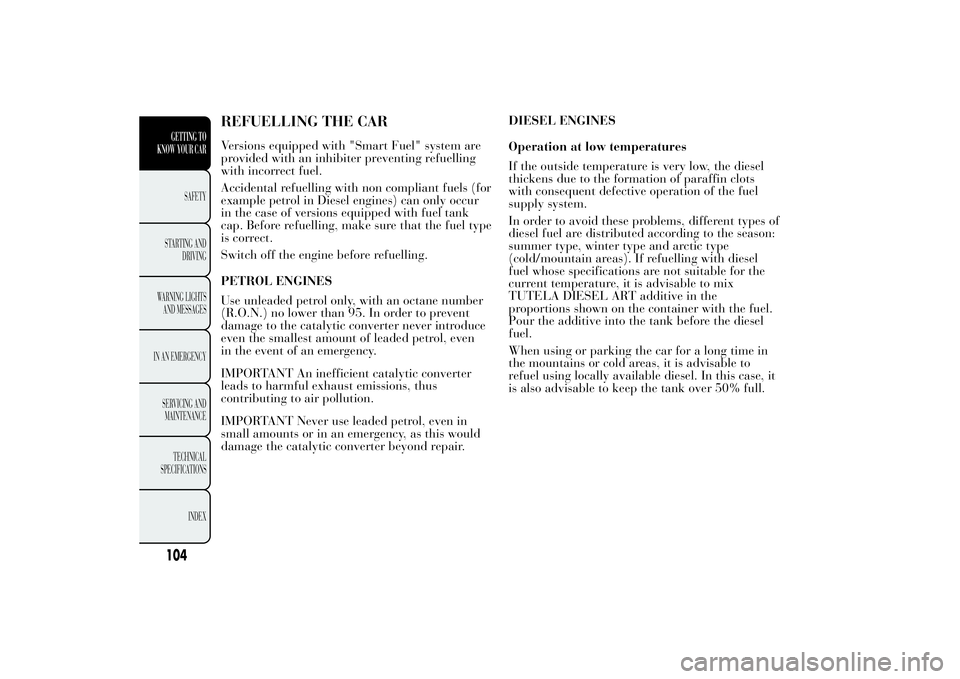
REFUELLING THE CARVersions equipped with "Smart Fuel" system are
provided with an inhibiter preventing refuelling
with incorrect fuel.
Accidental refuelling with non compliant fuels (for
example petrol in Diesel engines) can only occur
in the case of versions equipped with fuel tank
cap. Before refuelling, make sure that the fuel type
is correct.
Switch off the engine before refuelling.
PETROL ENGINES
Use unleaded petrol only, with an octane number
(R.O.N.) no lower than 95. In order to prevent
damage to the catalytic converter never introduce
even the smallest amount of leaded petrol, even
in the event of an emergency.
IMPORTANT An inefficient catalytic converter
leads to harmful exhaust emissions, thus
contributing to air pollution.
IMPORTANT Never use leaded petrol, even in
small amounts or in an emergency, as this would
damage the catalytic converter beyond repair.DIESEL ENGINES
Operation at low temperatures
If the outside temperature is very low, the diesel
thickens due to the formation of paraffin clots
with consequent defective operation of the fuel
supply system.
In order to avoid these problems, different types of
diesel fuel are distributed according to the season:
summer type, winter type and arctic type
(cold/mountain areas). If refuelling with diesel
fuel whose specifications are not suitable for the
current temperature, it is advisable to mix
TUTELA DIESEL ART additive in the
proportions shown on the container with the fuel.
Pour the additive into the tank before the diesel
fuel.
When using or parking the car for a long time in
the mountains or cold areas, it is advisable to
refuel using locally available diesel. In this case, it
is also advisable to keep the tank over 50% full.
104GETTING TO
KNOW YOUR CAR
SAFETY
STARTING
AND
DRIVING
WARNING LIGHTS
AND MESSAGES
IN AN EMERGENCY
SERVICING AND
MAINTENANCE
TECHNICAL
SPECIFICATIONS
INDEX
Page 107 of 299

For diesel engines, use only diesel fuel
for motor vehicles in accordance with
EN590 European specifications. The
use of other products or mixtures may damage
the engine beyond repair and consequently
invalidate the warranty, depending on the
damage caused. If you accidentally refuel with
another type of fuel, do not start the engine,
and drain the fuel tank. If the engine has been
run, even for only a very short time, you will
need to have the entire fuel system emptied in
addition to the tank.
REFUELLING CAPACITY
To fill the tank completely, top up twice after the
pump switches off. Further top-ups could cause
faults in the fuel feeding system.
REFUELLING PROCEDURE FOR VERSIONS
EQUIPPED WITH FUEL TANK PLUG
(for versions/markets, where provided)
Refuel as follows:
❒open the flap A fig. 84 pulling it outwards;
❒keep the plug B still, insert the ignition key in
the lock and turn it anticlockwise;
❒Turn the plug anticlockwise and remove it.The plug has a device C fig. 84 that attaches it to
the flap so that it cannot be lost. When refilling,
attach the plug to the flap, as shown.
After refuelling, fit the plug B fig. 84 (complete
with key) and turn it clockwise until it clicks once
or more. Turn the key clockwise and remove it.
Close the flap A.
The sealing may cause a slight pressure increase in
the tank. A little breathing off, while unscrewing
the plug or introducing the gun in the versions
equipped with "Smart Fuel", is therefore
absolutely normal.
fig. 84
L0F0240
105GETTING TO
KNOW YOUR CARSAFETY
STARTING
AND
DRIVING
WARNING LIGHTS
AND MESSAGES
IN AN EMERGENCY
SERVICING AND
MAINTENANCE
TECHNICAL
SPECIFICATIONS
INDEX
Page 108 of 299
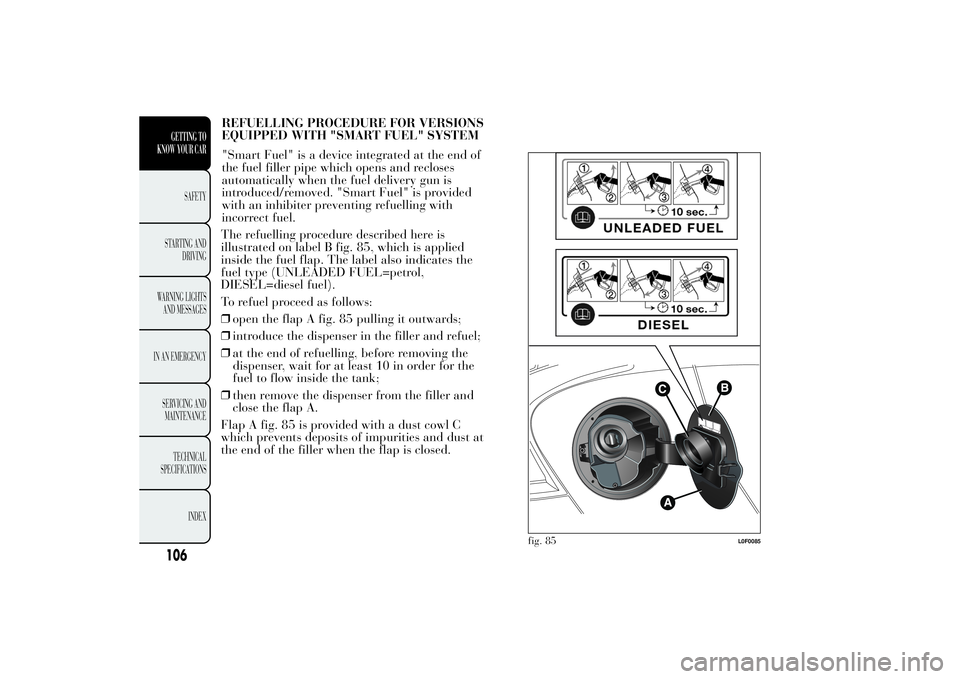
The refuelling procedure described here is
illustrated on label B fig. 85, which is applied
inside the fuel flap. The label also indicates the
fuel type (UNLEADED FUEL=petrol,
DIESEL=diesel fuel).
To refuel proceed as follows:
❒open the flap A fig. 85 pulling it outwards;
❒introduce the dispenser in the filler and refuel;
❒at the end of refuelling, before removing the
dispenser, wait for at least 10 in order for the
fuel to flow inside the tank;
❒then remove the dispenser from the filler and
close the flap A.
Flap A fig. 85 is provided with a dust cowl C
which prevents deposits of impurities and dust at
the end of the filler when the flap is closed.
fig. 85
L0F0085
106GETTING TO
KNOW YOUR CAR
SAFETY
STARTING
AND
DRIVING
WARNING LIGHTS
AND MESSAGES
IN AN EMERGENCY
SERVICING AND
MAINTENANCE
TECHNICAL
SPECIFICATIONS
INDEX
REFUELLING PROCEDURE FOR VERSIONS
EQUIPPED WITH "SMART FUEL" SYSTEM
"Smart Fuel" is a device integrated at the end of
the fuel filler pipe which opens and recloses
automatically when the fuel delivery gun is
introduced/removed. "Smart Fuel" is provided
with an inhibiter preventing refuelling with
incorrect fuel.
Page 109 of 299

Emergency refuelling (only for versions
equipped with "Smart Fuel")
If there is no fuel in the car or the supply circuit is
completely empty, proceed as follows to
reintroduce fuel in the tank:
❒open the luggage compartment and take the
adapter B located in the tool box (versions
equipped with space-saver wheel - for
versions/markets, where provided) fig. 86 or in
the Fix&Go Automatic container (versions
equipped with Fix&Go Automatic) fig. 87;
❒open the flap A pulling it outwards;
❒insert adapter B in the filler as shown in fig. 88
and refuel;❒after refuelling, remove the adapter and close
the flap;
❒reintroduce the adapter in the box and put this
back in the luggage compartment.
fig. 86
L0F0242
fig. 87
L0F0241
fig. 88
L0F0086
107GETTING TO
KNOW YOUR CARSAFETY
STARTING
AND
DRIVING
WARNING LIGHTS
AND MESSAGES
IN AN EMERGENCY
SERVICING AND
MAINTENANCE
TECHNICAL
SPECIFICATIONS
INDEX
Page 110 of 299
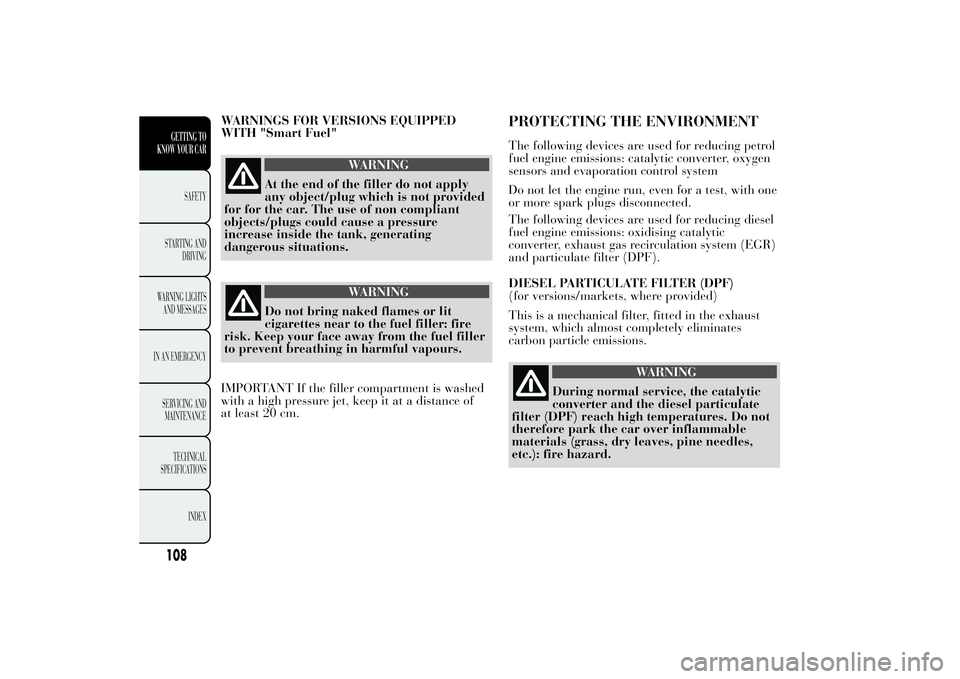
WARNINGS FOR VERSIONS EQUIPPED
WITH "Smart Fuel"
WARNING
At the end of the filler do not apply
any object/plug which
is not provided
for for the car. The use of non compliant
objects/plugs could cause a pressure
increase inside the tank, generating
dangerous situations.
WARNING
Do not bring naked flames or lit
cigarettes near to
the fuel filler: fire
risk. Keep your face away from the fuel filler
to prevent breathing in harmful vapours.
IMPORTANT If the filler compartment is washed
with a high pressure jet, keep it at a distance of
at least 20 cm.
PROTECTING THE ENVIRONMENTThe following devices are used for reducing petrol
fuel engine emissions: catalytic converter, oxygen
sensors and evaporation control system
Do not let the engine run, even for a test, with one
or more spark plugs disconnected.
The following devices are used for reducing diesel
fuel engine emissions: oxidising catalytic
converter, exhaust gas recirculation system (EGR)
and particulate filter (DPF).
DIESEL PARTICULATE FILTER (DPF)
(for versions/markets, where provided)
This is a mechanical filter, fitted in the exhaust
system, which almost completely eliminates
carbon particle emissions.
WARNING
During normal service, the catalytic
converter and the
diesel particulate
filter (DPF) reach high temperatures. Do not
therefore park the car over inflammable
materials (grass, dry leaves, pine needles,
etc.): fire hazard.
108GETTING TO
KNOW YOUR CAR
SAFETY
STARTING
AND
DRIVING
WARNING LIGHTS
AND MESSAGES
IN AN EMERGENCY
SERVICING AND
MAINTENANCE
TECHNICAL
SPECIFICATIONS
INDEX